Breaking Waves: Unlock Faster Backstroke Breakouts With 6 Key Drills (Video Demonstration)
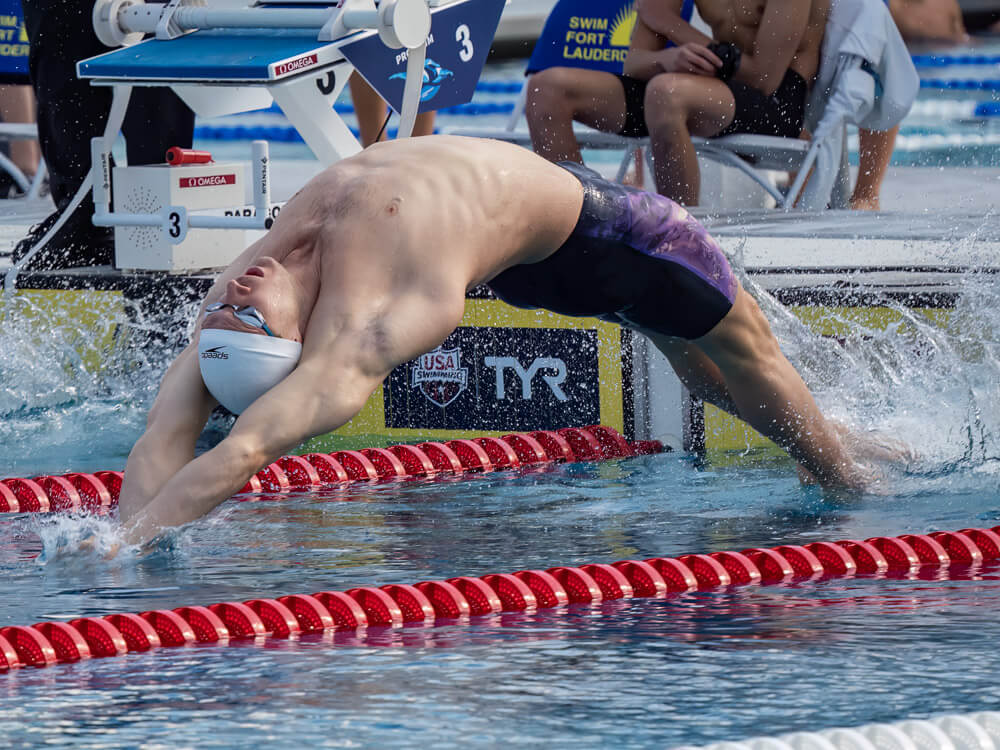
Breaking Waves: Unlock Faster Backstroke Breakouts with These 6 Cutting-Edge Drills
Umimplavat.cz is a swim analysis company which provided race and technical analysis for individual swimmers, clubs and national teams. The work of Umimplavat.cz is elite, and Swimming World is thrilled to bring you another analysis piece from the individuals behind the company. Previously, Swimming World ran the work of Umimplavat.cz in relation to the development of Romanian freestyler David Popovici.
In the below articles, the section headers are presented as active links which will allow readers to click to the points made by the authors.
****************************
Have you ever been there? Imagining all the things you want to do one day. You picture all the different scenarios. You want to do this. You want to do that. But in the end, you’re too busy and all your ideas live on in your mind. You find excuses…
… It’s not ready yet.
… I’m not ready for it.
.. the timing isn’t right.
… I haven’t figured everything out.
What happens is that you put all your big ideas and dreams aside. Maybe you’re afraid. Maybe you’re time is limited.
It was like that for us. In the last couple of months, we always thought of ways of delivering you insights and knowledge about the sport we love – swimming. But we kept pushing it back because it didn’t feel ready. We didn’t feel ready. But guess what? If you wait for the right timing, it’s never going to happen. So we thought it was about time to be active. And share even more with you.
We’re finally breaking out from our excuses and what better topic to start than breakouts? (See what we did there? Jokes aside, breakouts are an essential part of every race. It’s a fine line… either you find the right timing for your first strokes or you struggle the whole race to even get into the race. This is especially noticeable in sprint races.
So the thing is there are tons of drills out there you can include in your practice and improve your breakouts. But where to start, right We asked ourselves the same question. And we’ve decided on a sequence that makes the most sense in our opinion: Starting with backstroke.
In the following post, we list six backstroke breakout drills, including the main goal of the drill, key points to keep in mind while executing the drill, and which mistakes you can eliminate.
We also included a YouTube link to each drill.
Ready to break down the 6 essential drills?
1. Backstroke Breakout – Coordination of the First Stroke
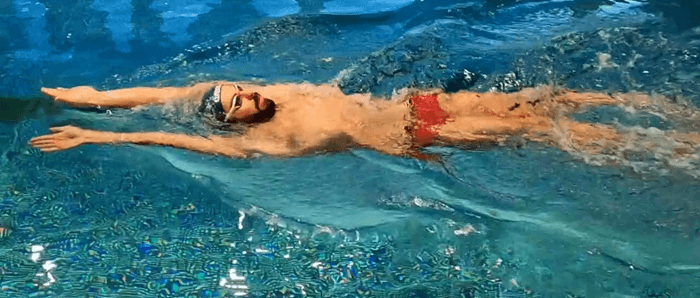
Photo Courtesy:
Goal of the drill: To correct the coordination of your movements while breaking the surface.
What mistakes can it help to eliminate?
- Incorrect timing of your movements while breaking the surface.
- Problems with your upper and lower limbs coordination when breaking the surface.
Key points to keep in mind
- Finish the first arm pull at the same time as finishing the last kick to the surface.
- At the breakout moment, underwater undulation is combined with the first arm pull. After the last dolphin kick (end of the arm pull), you transition into the flutter (typical backstroke) kicking.
- We recommend you to practice this breakout drill regularly in each backstroke set (and after each turn), in order to automate this movement pattern.
2. Backstroke Breakout – Push Off From the Bottom of the Pool
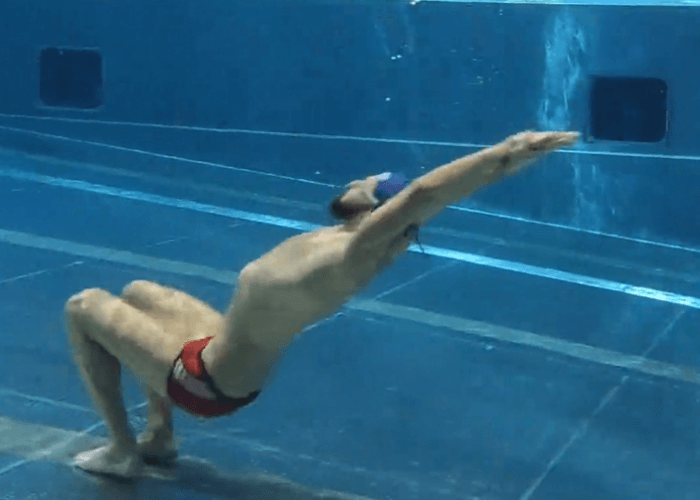
Photo Courtesy:
Goal of the drill: Practice the coordination of your first stroke when breaking the surface after the start and after the turn (transition between the underwater phase and clean swimming).
What mistakes can it help to eliminate?
- Incorrect timing and coordination of the arm stroke and leg kick when breaking the surface.
- When the first arm stroke is performed too deep.
- Flutter kicks (typical backstroke kicks) that don’t flow the previous dolphin kicks fluently.
- Ineffective head position (chin-down) during the breakout.
Key points to keep in mind
- Strong push-off from the bottom of the pool, to gain speed. We recommend performing this drill at a pool with different levels of the floor and trying to push off at the beginning of the bottom slope into greater depth.
- This drill can help to break the surface several times in a row, without changing the direction of the swimming.
- The end of the arm stroke comes at the moment of finishing the kick “into” the surface.
- After breaking the surface, let the body glide as far as possible to control the efficiency of the breakout movement.
- This drill is only a practice for the correct timing of the first arm stroke and the last dolphin kick.
- After breaking the surface and finishing the last dolphin kick (with the first arm pull), you fluently transition into the flutter kicks (typical backstroke kick) kicking and start to swim backstroke.
3. Backstroke Breakout – One-Hand Catch (slow speed)
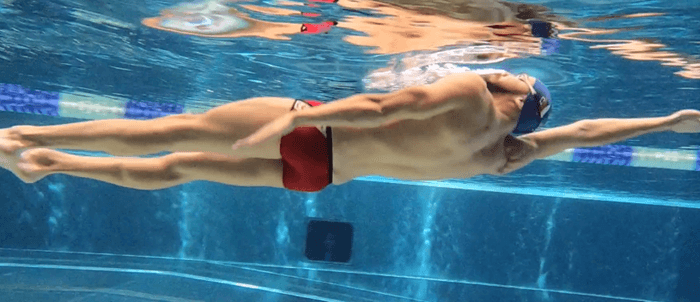
Photo Courtesy:
Goal of the drill: Practice the coordination of your first stroke when breaking the surface after the start and after the turn (transition between the underwater phase and clean swimming).
What mistakes can it help to eliminate?
- When the first arm stroke is performed too deep.
- Ineffective head position (chin-down) during the breakout.
Key points to keep in mind
- The end of your arm stroke comes at the moment of finishing the kick “into” the surface.
- After breaking the surface, let your body glide as far as possible to control the efficiency of the breakout movement.
- After breaking the surface and finishing the last dolphin kick (with the first arm pull), you fluently transition into the flutter kicking (typical backstroke kicks) and start to swim backstroke.
4. Backstroke Breakout – One-Hand Catch (fast speed)
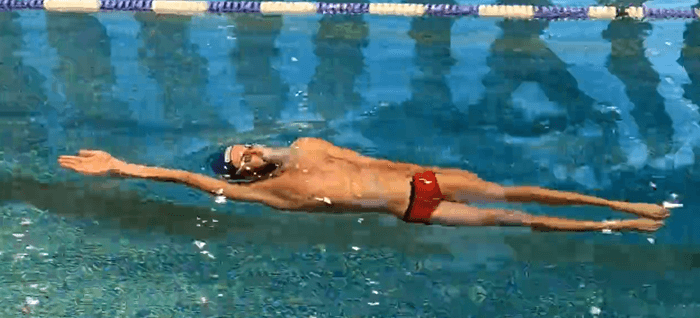
Photo Courtesy:
Goal of the drill: Practice the coordination of the first stroke when breaking the surface after the start and after the turn (transition between the underwater phase and clean swimming).
What mistakes can it help to eliminate?
- Incorrect timing and coordination of the arm stroke and leg kick when breaking the surface.
- When the first arm stroke is performed too deep.
- Ineffective head position (chin-down) during the breakout.
Key points to keep in mind
- The end of your arm stroke comes at the moment of finishing the kick “into” the surface.
- After breaking the surface, let your body glide as far as possible to control the efficiency of the breakout movement.
- This drill is only a practice for the correct timing of the first arm stroke and the last dolphin kick.
- After breaking the surface and finishing the last dolphin kick (with the first arm pull), you fluently transition into the flutter kicking (typical backstroke kicks) and start to swim backstroke.
5. Full Motion: Master the Complete Backstroke Breakout (slow speed)
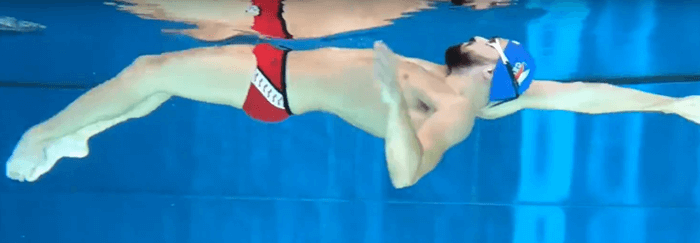
Photo Courtesy:
Goal of the drill: Improvement of the transition between underwater undulation and surface swimming; Utilizing faster underwater movements to reach your race speed more quickly; The fluent transition from underwater undulation to flutter (typical backstroke) kick.
What mistakes can it help to eliminate?
- Incorrect coordination/timing of arm and leg movements during the breakout
- Velocity decrease during the breakout.
Key points to keep in mind
- Set your optimal number of underwater kicks after the start and after each turn (e.g. 6)
- For longer underwater distances, it is necessary to direct the push-off from the wall slightly downwards.
- Focus on fluently ascending to the surface with lower kick amplitude. Any fast change of movement or direction will increase the frontal drag and cause the deceleration of the speed during the breakout.
- The last underwater dolphin kick has to be finished “into the surface”.
- The timing of the last underwater dolphin kick should be synchronized with the end of the first arm stroke, in order to continuously transition into clean swimming.
- For a stronger end of the first arm stroke, it is possible to help with the shoulder/hip rotation.
Lower level (regression)
- Put on fins, in order to get the feeling of higher speed during the breakout.
- You can reach a higher breakout speed by pushing off from the bottom of the pool. The more shallow the level of the surface is the easier the execution of the fast breakout gets (optimal angle of your body when breaking the surface).
Higher level (progression)
- Do the drill with resistance aids/tools (resistance swimsuits, resistance socks, etc.).
6. Freestyle Breakout – Underwater Back-to-Chest Transition
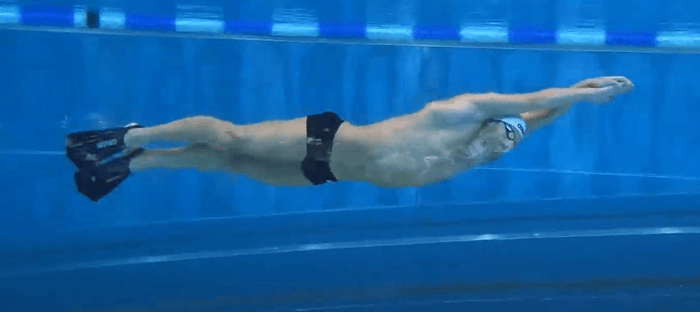
Photo Courtesy:
Goal of the drill: Improvement of the undulation and breakout technique; Improvement of the transition from back to chest after the turn; Increasing the kick strength; Increasing the core muscle strength; Improving the underwater orientation; Option of underwater undulation technique for freestyle disciplines.
What mistakes can it help to eliminate?
- Irregular kick beat
- Interruption of the kick movement during the back-to-chest transition.
- Too weak kicks.
- Incorrect movement coordination when transitioning from the undulation into the flutter (normal freestyle) kicking.
Key points to keep in mind
- Before the push-off from the wall, your arms are fixed, stretched out, and joined together.
- Immediately after the push-off (slightly down) the swimmer has to set an effective streamlined position on the back.
- The first underwater dolphin kick should be performed right before his/her velocity starts to decrease. The timing (estimation) of this moment is mainly based on the swimmer´s subjective perception and “feeling of the water”.
- The direction of undulation during the underwater phase is slightly downwards after the push-off, then parallel to the surface (after the first or second kick), and smoothly ascended to the surface in the second half of the underwater distance before the breakout.
- The undulation movement starts in the “chest” (thoracic part of the spine), continues through the hips and knees, and fades out in relaxed ankles.
- You rotate around the longitudinal axis of your body until reaching the chest position. The undulation is performed continuously in the same rhythm/beat and intensity.
- The breakout is performed “into” (with) a high body position. The head breaks the surface first, followed almost simultaneously by the upper part of your body and then the lower part of your body. The end of the first arm stroke (upsweep) is synchronized with the last dolphin kick. Thereafter, your legs are “switched” into the flutter (crawl) kicks.
Higher level (progression)
- Perform the drill without fins.
- Use this drill in freestyle sets (after each turn) during your practice.
- Try to use this “back-to-chest” undulation option after the start and after each turn in the race.
- Equipment: Fins
And there you have it. Six drills you can directly implement in each practice and improve your backstroke breakout. To make it a little easier for you, we created especially for you a YouTube playlist with all the drills in one place, in the right order. So it’s easier for you to watch.
Let us know what you think and if posts like this help you.
What drills do you want to hear next about? Comment below or shoot us a DM. Looking forward to hearing from you.
If you want to learn more about umimplavat.cz and our mission to change the swimming universe, just visit us on Instagram, Facebook, or LinkedIn. Also, every other week, we’re going to publish some magnetic insights into our work on our blog. Let’s keep in touch!



